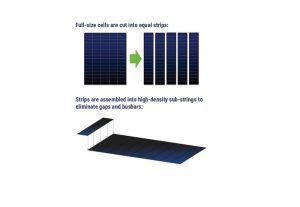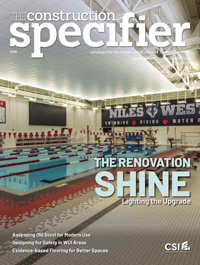Considerations for integrating solar power in new construction

However, technologists, architects, and builders’ vision of attractive integration of PV into new construction does not have to end with more attractive rooftop solar panels. In fact, deploying solar on the roof is only the beginning. Building integrated PV (BIPV) and architectural solar—embedding PV in building façades—is an area showing tremendous promise.
Rather than mounting a solar panel to a structure’s rooftop, BIPV adapts a typical building component, such as a window, spandrel panel, or other cladding, to produce electricity. If a BIPV component were to be removed from a structure, the resulting gap in the façade would be filled with a substitute building material (e.g. concrete).
BIPV is most suitable for buildings with a high proportion of roof to glazing, such as multistory commercial structure, and for specialty applications like greenhouses. In fact, the only way many commercial buildings will be able to achieve net zero-energy status—an objective pursued by an increasing number of architects, owners, and developers—is to incorporate BIPV into their construction.
The author’s experience shows both the challenges and the opportunities of BIPV. The author’s firm introduced a transparent glass material in 2017 with an almost invisible electric generation capability. Mass-produced PV cells were sliced into thin strips, and embedded between glass layers in a window. Thanks to the human visual perception, the PV is not obvious when looking through the window.
This offers building owners and occupants’ several benefits in addition to electric generation: the PV strips absorb light hitting the building’s windows, reducing the solar heat gain coefficient (SHGC), the building’s internal temperature, in the warmer months, and retaining warmth in the cooler months, thereby lowering air-conditioning/heating costs and increasing comfort.
However, commercial uptake of this material has been limited for reasons worth expanding on, in part because each one is or will be addressed in ways relevant to specifiers.
Multiple stakeholders
The success of BIPV relies heavily on collaboration by building owners, architects, engineers, construction companies, glaziers, building envelope suppliers, and civil electrical contractors. The required level of coordination can be daunting.
Limited supply chain
BIPV is low volume and therefore difficult to source, and currently somewhat expensive.
Fabrication and construction skills
Installing BIPV, including wiring, glazing, and/or spandrels to a building power system, has construction implications that introduce uncertainty until additional experience and expertise are acquired. (A fact further preventing greater acquisition of that experience and expertise).
Warranties and support
The industry’s experience with solar panel reliability is high, and the effort required to physically swap out a panel is relatively low. However, BIPV introduces an entirely new set of considerations, since glazing, cladding, and other components add layers of complexity.

As is apparent, there is a certain ‘chicken-and-egg’ quality to BIPV. Greater volume requires additional experience and expertise for developers, builders, contractors, and owners, which is not (yet) widely available. Increased demand is dependent on garnering greater expertise in this arena.
When the author’s company experienced this dilemma, it responded by supplying the technology to manufacturers of glass, commercial window, and cladding systems. The belief is once BIPV is more widely offered by established companies, the concerns enumerated above will vanish.
To truly mainstream BIPV and net zero-energy buildings, architects and developers must design structures with solar PV from the beginning, rather than apply it as an afterthought to the structure. This will necessitate looking holistically at a new project, determining prior to commencement of construction what a building’s energy consumption will be, as well as its carbon footprint and ecological impacts. Armed with these insights and knowledge, there are increased opportunities to design and build world-class, aesthetic buildings with solar PV in their skins.
Products offering the greatest energy yield affordably and efficiently will prove to be the perennial winners in a competitive market. Reputable solar manufacturers offer 25-year warranties on power, performance, and workmanship of solar panels. Increasingly better rates of cell and panel efficiency continue to be drivers when it comes to lasting success.
The industry is on the threshold of a new era in design and construction of homes and commercial structures. There will be demand for solar-outfitted rooftops, windows, walls, and building façades, especially since many commercial buildings do not have a practical way of offsetting energy costs due to the constraints posed by limited rooftop space. Structures offer vast potential for generating clean electricity, while providing tremendous cost savings. There are significant opportunities to shift the operational power equation from energy net losses to net gains.
By deploying solar, developers, construction professionals, and building owners will increasingly be transforming structures into highly efficient generating assets with an aesthetically pleasing look.
Specifiers will be seeing increased demand for high-efficiency rooftop solar panels, as well as architecturally aesthetic PV embedded into structures. Undoubtedly, communities and municipalities will increasingly be requiring commercial structures that are ‘green’, and meet sustainability standards. Urban planners will be looking to specifiers for the latest in PV and energy storage technologies.
Cornell Tech’s net zero-energy campus in New York City, outfitted with PV panels, serves as an exemplar for rooftop solar power on new structures being designed and built through the United States. The new Kirin Beer facility in Yokohama, Japan, is an example of how beautiful BIPV can be deployed in a new building.
Solar innovations have the potential to drive global transformations in architecture, design, and construction to help meet the sustainability goals of today’s—and future—generations. The solar industry is geared up to respond. It promises to be an exciting time. The sky is the limit.
Suvi Sharma is CEO of Solaria Corporation, headquartered in Oakland, California. He can be reached at sdevico@solaria.com.


